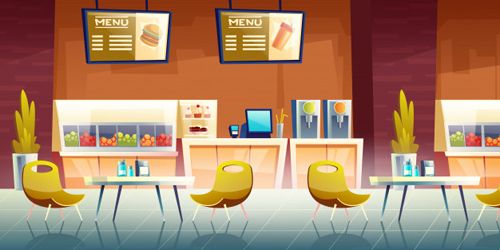A cafeteria, sometimes known as a canteen outside the United States, is a type of food service location, where there is little or no table service for waiting for staff, whether in a restaurant or an organization such as a large office building or school; A school dining location is also referred to as a dining hall or lunch (in American English). The food is usually kept in a tray, which is delivered to a cashier’s station and customers take it to a dining table. Instead of table services, there are food delivery counters or booths, allowing them to walk in any line or arbitrarily. Also, there are often stations where customers order meals, especially items such as hamburgers or tacos that should be served hot and can be prepared immediately with little waiting. It also has a teacher’s lounge for faculty members where they can eat their snacks and lunches and read the newspapers. A variety of snacks, including fast food and traditional food, are available at BUBT Cafeteria. This system often allows unlimited secondary services for free. For legal purposes (and the type of consumer service to customers), this measure is rarely used for alcoholic beverages in the United States.
Since cafeterias require a few employees, they are often found in a larger organization, providing clients for that organization. For example, schools, colleges, and those: residential halls, department stores, hospitals, museums, places of worship, amusement parks, military bases, prisons, factories, and office buildings often have cafeterias. The modern cafeteria, designed to facilitate the smooth flow of patrons, has specially adapted to the needs of institutions, schools, hospitals, corporations, and the organizations needed to serve an affordable number of people. In addition to providing fast service, cafeterias require fewer service staff than other commercial catering establishments. At one time, upscale cafeteria-style restaurants dominated the culture of the South American United States and, to a lesser extent, the Midwest. These included many prominent chains: Beckford, Morrison’s Cafeteria, Piccadilly Cafeteria, S&W Cafeteria, Apple House, Lobby, K&W, Britling, Whits Cafeteria, and Blue Boer. It was founded in 1891 by YWCA, Mo., food industry historians in Kansas City, considering it the first cafeteria. Founded to provide low-cost meals for working women, the organization was designed as a luncheon club for women in Chicago where some aspects of self-service were already practiced. With the exception of K&W, these establishments went into decline with the rise of fast-food in the 1960s and largely ended in the 1980s with the rise of “casual dining”. Several chains, particularly the lobby and the Piccadilly Cafeterias (which took over Morrison’s chain in 1999), have been filling in the gaps since the fall of the old chain. Cafeteria caterpillars were introduced to the public in several American cities in the 1890s, but cafeteria service did not expand widely until shortly after the turn of the century when it became an acceptable method of catering to factory workers and other large businesses.
















